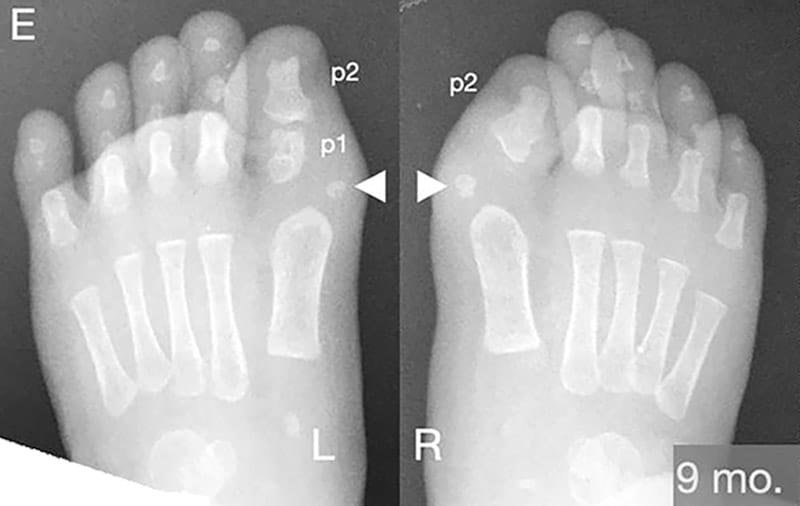[Author: Laura Cowen]
A detailed analysis of radiographs from individuals with ACVR1R206H -mutated fibrodysplasia ossificans progressiva (FOP) has found that great toe malformations result from monophalangeal and biphalangeal phenotypes.
Moreover, Eileen Shore (University of Pennsylvania, Philadelphia, USA) and co-investigators say they “identified altered patterns of growth and morphology along the proximal-distal axis of the forefoot including aberrant skeletal elements and ectopic ossification centers consistent with the malformed, short great toes that are a characteristic and diagnostic clinical feature of FOP.”
The researchers reviewed radiographic images of the feet of 41 people with FOP (54% male) aged between 2 months and 48 years.
They report in Frontiers in Cell and Developmental Biology that their examination of primary ossification centers (POCs) in digit 1 (the great toe) “provided an improved picture of prevalence” of previously recognized FOP features.
For example, all participants had metatarsal malformation and 93% had a nearly fully penetrant hallux valgus. The same proportion had an ectopic ossification center medio-distal to the head of the first metatarsal and 51% had loss of the interphalangeal joint associated with loss of the proximal phalanx.
The investigators also identified two novel presentations of the great toe phenotype: the first, termed monophalangeal hallux, was characterized by the absence of the proximal phalanx of digit 1, while the second, namely biphalangeal hallux, included a malformed proximal phalanx in this position.
Twenty participants were monophalangeal for the first digit in both feet and twenty were biphalangeal, whilst one individual was biphalangeal in one foot and monophalangeal in the other.
Shore et al say that these two phenotypes “might at first seem likely to be explained by background genetics of individual subjects; however, one subject having both presentations, one in either foot, suggests that instead, the FOP mutation, and its resulting increased [bone morphogenetic protein] pathway signaling, broadly dysregulates the signaling pathways that determine the proximal-distal pattern of ossification in the first digit.”
The researchers also looked at secondary ossification centers (SOCs) in digit 1 and both POCs and SOCs in digits 2 to 5.
They found that both monophalangeal and biphalangeal cases of FOP showed a variety of dysmorphic SOCs in the great toe, including expansion on the proximal-distal axis, an hourglass-like shape with varying degrees of asymmetry, and delta phalanx.
In addition, 76% of biphalangeal participants also had the rare longitudinal epiphyseal bracket (LEPB) malformation in the proximal phalanx, which in some cases (14%) involved a novel malformation whereby a compound LEPB produces concentric, ossified semi-circles.
The team also reports that “[i]n contrast to metatarsals of the first digit, metatarsal malformations in digits 2–5 of subjects with the FOP ACVR1R206H mutation were extremely rare.”
Indeed, just two participants had apparent proximal, rather than distal, secondary ossification centers of all metatarsals in digits 2–5, and 22% had an absent middle phalanx of digit 5.
Shore and co-authors conclude: “Although causal relationships among the phenotypes reported here cannot yet be conclusively established, these data provide a more comprehensive and detailed view of the developmental phenotype of the great toe in patients with FOP and provide new insight into the roles of ACVR1 and [bone morphogenetic protein] pathway signaling in human skeletal and joint development.”
